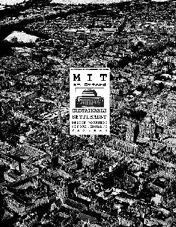The New Practitioner:
Dialogue Tools And Techniques
4.237 (H), Units: 3-0-6, Spring Semesters
Instructor: Reinhard Goethert
The course focuses on tools and techniques necessary for effective dialogue with non-traditional client groups: communities, the poor and the generally excluded middle income. The purpose is to expose future professionals to a new paradigm of service-oriented practice and to develop a rudimentary awareness of interactive processes.
COURSE DESCRIPTION
The course is biased toward the notion that dialogue not monologue is essential for an efficacious and creative design process. It accepts that active user involvement is essential to good architecture. In this context the design of tools and techniques is integral to the design of the building itself.
The course will provide an introduction to a new paradigm for practice and provides hands-on experience in dialogue with client groups. The course will explore both indirect dialogue tools (handbooks, how-to-do leaflets, videos, and home-user computer design programs) as well as direct interaction with clients and appropriate tools and techniques drawings, models, design kits.
We will study: New Practice Paradigms; Past Experience; Future Alternatives
We will review: Handbooks; How-to-do Leaflets, Self-Help Videos
We will experiment with: Interactive model games; Community workshop techniques;
DIY Computer Programs
We will visit: Community Organizations; Community Meetings; City Agencies; Practitioners
The course will meet once per week for 3 hours, with additional outside assignments. Emphasis is on practical hands-on experience supplemented by background readings. Fulfillment of several research assignments chosen by the student is required, as well as a short reflective essay on an aspect of the new paradigm of practice.
Throughout the semester resource professionals will be brought in to present and discuss their experience on specific tools and techniques.
Students are encouraged to continue their research into tools and techniques during the Spring semester.
Outline: THE NEW PRACTITIONER: DIALOGUE TOOLS AND TECHNIQUES
I. The search for a new paradigm
INTRODUCTION
Why is there a problem? Should there be a change in practice? What is the current situation in the practice of architecture?
Basic goals and structure of course. General overview of material to be covered and what will not be covered. Administrative arrangements.
BACKGROUND AND CONTEXT
What is the nature of housing today? How does housing differ in the Third World from the developed world, and particularly the US? What is the breakdown of housing sectors by income? How do self-builders feature in the supply of housing in the Third World as well as the industrialized countries? What technological approaches have been tried and what is the experience?
Positioning of the housing supply sectors by type and magnitude. Review of previous failures of formal responses based on professional as dominant. (Operation Breakthrough in the US, Habitat and PREVI Competitions in the Third World)
Assignment 1: Review and present to class selected context reports on the non-formal housing in both the Third World and the developed countries.
II. Tools and techniques
INDIRECT/PASSIVE DIALOGUE TOOLS
How do you participate? Who are the clients: users or companies? Are these really monologues and not effective vehicles for interaction with users? What is the purpose and audience of each tool? How effective are they? What are the alternative ways of reaching out?
Class 1: Passive/written: "How-to-do" Leaflets
Class 2: Passive/written: Handbooks.
Kenya LDP),
Assignment 3: a) Select handbook which informs users how-to-build their own house; b) Review the background/source, scope and detail, target user, and evaluate effectiveness; c) Write up and present to class.
Class 3: Passive/video: "How-to-do" videos
Class 4: User-active: home-user computer design programs
Assignment 4: a) Select one of the design-it-yourself disks that is available for under $50 or so.
b) Have another person (non-architecture student/person) design his/her dream house on a lake. Observe the process, and try to understand why and the sequence things were done., c) Write up observations (include final design) and present to class.
DIRECT/ACTIVE DIALOGUE
What is your role? Who are the clients? What are the most effective techniques? Action-planning. Participatory design. Which are best as dialogue-supportive and which could be used as active dialogue mediums?
Class 5: User interactive techniques: Models
Class 6: User interactive techniques: Games
Pakman,
Class 7: Interactive methodologies: Rapid consensus building/action planning.
Micro-Planning, DSNI Young Architects Project, Pakman, Planning for Real
Class 8: Supportive Tools
Techniques and tools that architects use to make clear their intent and to dialogue with communities and other clients.
Assignment 5: a) Identify a community meeting with architect involvement; b) Attend the meeting as passive observer and observe proceeding, noting particularly the architects involvement: his role, his contributions, and his techniques; c) write up your observations and present to class.
Class 9: Case Study Villa Victoria. Guest - Architect John Sharratt.
AFTER-THE-FACT DIALOGUE
What is the use once it is finished? What are good metaphors to assess? What techniques are most successful? How can users become involved in assessment?
Class 10: Professional and User-involvement Techniques: Professional tools: visual surveys, interviews; User-involvement techniques: drawings, surveys.
Assignment 6: a) Select a built environment and identify common users; b) Solicit 1-2 users and train them in carrying out a user assessment; c) Write up the assessment and present to class. Attach the user assessment results.
III. A New Practitioner
DIRECTIONS FOR A NEW PARADIGM
What has been the experience with alternative practice? What are the characteristics of the "new" practice? (what would you do) Who are the "new" clients? (who do you work with) What would be the vision of a new practice? How could a practice work when confronting practical office realities? How do tools and techniques influence and/or make possible a new way of working?
Class 11: Review of dialogue forms available to the architect. Exploration of potentially fruitful directions for the architect.
Assignment 7: Reflect on potential new roles for the architect and what this would imply in practice. Explore the nature of a new practice. Use examples from the class to illustrate what kinds of techniques he/she would need to be proficient in.


